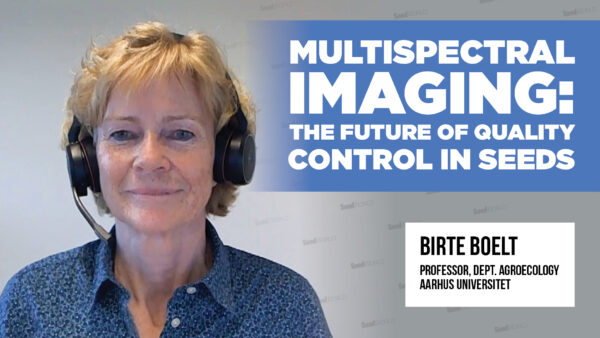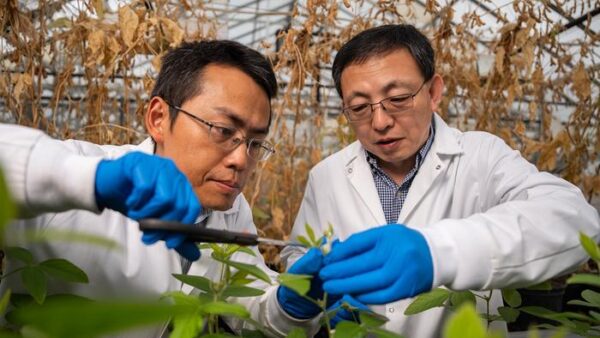Experts believe the key to helping growers break the next yield barrier lies below the ground — root and soil health and the interaction between the two. Ensuring that a crops’ root system is protected early on can make a big difference at harvest.
When you’re slowly driving down the road and looking out over the fields, you take comfort in seeing big green leaves, a nice even stand and those perfectly spaced rows. But if that’s not the case and the leaves are yellow, starting to roll or there’s a great deal of variability, you rub your forehead knowing there’s a problem — it’s easy to see. But the picture is much darker when we look at what’s happening below ground.

“Nobody looks out across the field and thinks of roots,” says Dale Ireland, Syngenta Seedcare technical product lead for U.S. corn and soybeans. “Roots don’t really get the respect that they should, but that’s where the next yield frontier is, below ground.”
In the competitive spirit, farmers always want their crop to look better than their neighbors’, but what if, for illustrative purposes only, we turned that crop upside down and the roots were out of the ground. Then it would be easy to see who makes sure their roots are protected, healthy and strong.
Shawn Conley, a University of Wisconsin Extension soybean specialist, says he’s never seen a high-yielding field with one skinny little taproot. “Typically when you dig up roots in a high-yielding field, you have a very long taproot, 24-36 inches long, with a massive secondary root system and a very fibrous structure.”
The Role of Roots
Roots are the interface between the plants and the soil. The plant depends on roots to keep it erect. It’s very basic, Ireland says, but essential to growth, development and harvestability.
Roots are responsible for four key functions:
• Anchoring the plant in the soil.
• Uptake of water and nutrients.
• Conducting water and nutrients.
• Storing food.

Amy Burton, a root physiologist for Bayer, says that yield building starts on day one. One area Burton has been focused on is helping plants be more efficient with carbon, in turn allowing the roots to be more efficient in accessing water and nutrients.
“Germination is one of the most challenging times in a plant’s life,” Burton says. “Seedling establishment is very important. The sooner the plant can establish itself, the stronger and more vigorous it will be later in the season.”
When the plant goes to fill seed, if it doesn’t have an adequate root system for nutrient and water uptake, it won’t be able to fill as much and results in a lower yield. Ireland explains that until the plant is 2 to 3 feet tall, the root system underground should be just as big or bigger than the plant above the ground.
When soybeans flower, if the plant doesn’t have a good root system, it will begin to kick off flowers or pods if it’s under stress. Conley says that you could have a great looking crop that doesn’t visually show stress, but there could be a lot fewer pods out there than one might suspect.
Ireland says cotton, which also has multiple fruit positions, is especially sensitive to photosynthesis and chlorophyll. “For the plant to be able to produce enough carbohydrates and sugars, it needs a good healthy root structure to pull the nutrients it needs,” he says, noting that without that, yield potential is limited. But it all starts with planting the seed.
What’s Happening Below Ground?
Certainly genetics are an important foundation, so we’re focused on protecting those genetics, Ireland says. “When you think about seed, it has the most genetic potential sitting in the bag,” he adds. “Once it’s out of the bag, there are a number of things that begin stressing the seed, both biotic and abiotic.”
Greg Ginisty, a Bayer SeedGrowth product manager, agrees. “Everything tries to reduce genetic potential after it’s out of the bag,” he says, noting that seed treatments can really complement genetics. “Very few traits exist to control secondary insects, and that’s where seed treatments can make a big difference.”
Conley notes it’s important to recognize that growers have cut back on their seeding rates. “Four or five years ago, it was a 50-pound bag of seed; now it’s 140,000 seeds per bag, and each seed has a value,” he says. “The seed costs more money, so they are putting less of it out there and putting it out there earlier.”
According to “Benchmarking soybean production systems in the North-Central USA,” a report put together by the University of Wisconsin, Madison; University of Nebraska, Lincoln; and the North Central Soybean Research Program, most farmers are planting 140,000 to 160,000 seeds per acre. Roughly five years ago those farmers were planting 170,000 to 200,000 seeds. That’s 30,000 to 40,000 fewer seeds in the ground.
When that seed is planted into the soil, it’s exposed to a number of stressors. First, as farmers look to plant earlier and earlier, the soil temperature is colder and often wet. Depending on location and crop cycle, there might be Pythium, Phytophthora, nematodes or other subterranean destructors.
Minus the variability of the weather, Conley says the biggest concern is seedlings’ susceptibility to Pythium.
According to the University of Illinois Crop Sciences Department, Pythium occurs in wet, cool conditions and in low, poorly drained areas, particularly on clay, compacted soils. The soilborne, fungal-like pathogen can attack and rot seeds and seedlings prior to emergence and can cause post-emergence damping off under wet conditions. Symptoms include soft, brownish-colored rotting tissue. In established plants, secondary roots can be soft and rotted.
Phytophthora is another yield-robbing pathogen that causes similar symptoms. Conley says that Phytophthora is more of a concern as you get into Ohio and other areas where there’s more no-till and bean-on-beans.

Jennifer Riggs, Bayer SeedGrowth product development manager, says that these pathogens exist in most farmers’ soils, but it’s the environment that triggers them to become active.
Conley adds that sudden death syndrome (SDS) and soybean cyst nematodes (SCN) are spreading to newer production regions. Couple that with the breakdown of PI88788 and there are more entry sites on the root for different pathogens to take advantage of.
Nematodes are decimating global harvests of some of the most important staple foodstuffs. In the Midwest, nematodes are responsible for a 5 percent to 10 percent yield loss in corn.
Riggs says that of all the pests, nematodes are one of the hardest to control and hardest to see because they don’t cause many above-ground symptoms, but they can sure impact yield.
Root Protection
Knowing this, companies such as Bayer, BASF and Syngenta have been at work on new formulations to protect the seed as it germinates and grows.
Bayer has brought two relatively new products to market to help with nematodes — ILeVO and VOTiVO. Riggs explains that ILeVO protects seedlings against nematodes when roots are within 6 to 8 inches of the seed zone. Then VOTiVO, a biological, is a bacteria that grows and multiplies on the root surface.
The bacteria creates a secretion that actually blocks the nematodes from being able to find the root, Riggs explains, and that prevents feeding and reproduction.
She says that those two products are being combined on the seed to provide increased protection as the plant grows.
Then there’s Poncho/VOTiVO, which was first introduced on corn in 2010 and then introduced on soybeans in 2012. It combines the biological with a systemic insecticide that’s absorbed by new roots. Riggs says when Poncho/VOTiVO is applied to soybeans, the average yield benefit is doubled when the seed is planted early in the first two weeks of a six-week window.
Burton says that the seed treatment actually changes the structure of the root system, allowing it to conserve more carbon. With a more carbon-efficient root system, the plant can grow new roots into unexplored areas of the soil. This enhanced soil exploration is important for early season capture of nitrogen, as well as accessing deep stores of water during periods of drought.
Syngenta’s researchers have also been working to help farmers fight off the $1.5 billion SCN pest. The company introduced Clariva Complete Beans, a seed treatment that pairs a nematicide with the insect and disease protection of CruiserMaxx Beans with Vibrance insecticide/fungicide seed treatment.
Ireland adds that the active ingredient in Clariva Complete Beans is Pasteuria nishizawae — spores that are released into the surrounding soils.
“These spores attach to the outer layer of the second-stage juvenile SCN as they pass through treated soil,” he says. “Once attached, the spores produce germ tubes that penetrate and infect the nematode’s interior body.
“The infection results in reduced SCN reproduction and feeding, and ultimately leads to the death of the nematode. As the remains of the deceased nematode decompose, P. nishizawae spores are once again released into the soil and will infect new generations of SCN.”
Companies continue to invest in new research to help protect crops, with more and more emphasis being placed on the roots and their surrounding environment. Many experts agree that root growth that is lost early is often not re-gained, so protection is critical.
Evidence shows a strong correlation exists between seed treatments, root growth and yield.
Conley encourages retailers and growers to dig up roots and look below ground all season long. “This will help you to make better decisions for the following year — what crop to plant, what varieties to select, what actives to use and at what rates,” he says. “If you don’t know what’s limiting yield, you won’t be able to manage it.”
Learn More
Join Seed World Sept. 29 at 1 p.m. Eastern/10 a.m. Pacific for a webinar to get a more in-depth look at the role roots play in increasing yield and how seed treatments fit into that picture. During the webinar, participants will uncover what’s happening below ground, learn about the role of roots in plant nutrition and explore how seed treatments can protect the roots. There’s no cost to register.
Registration is now closed.












